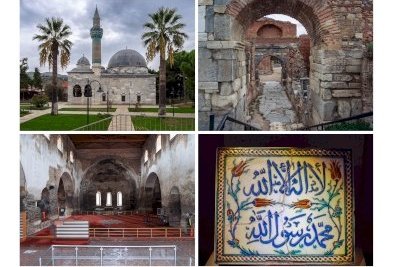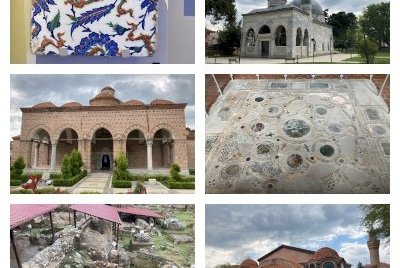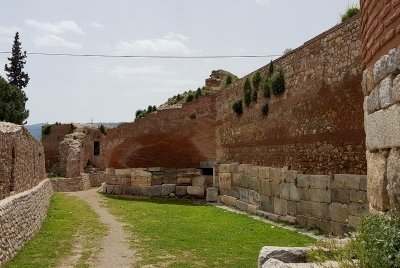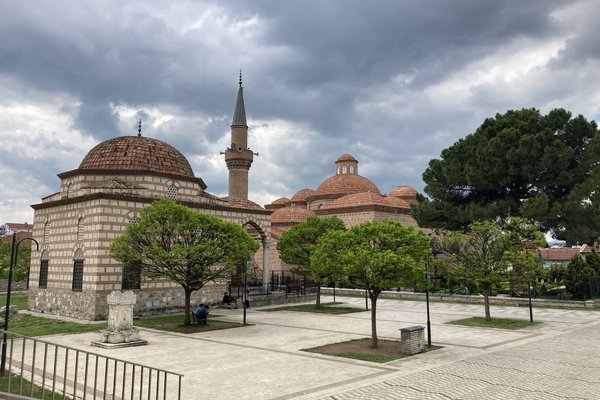Turkiye
Iznik
İznik is historically known as a center for ceramic production.
The İznik tiles spread across the Ottoman Empire and to the museums of the world. Historically, it was called Nicaea, known for the Christian landmark council of bishops: “the first Council of Nicae”. It was also the Seljuk and Ottoman capital for short periods.
Community Perspective: Go for the formidable City Walls, the kilns, the Green Mosque, the Hagia Sophia and the modern Archeological Museum.
Site Info
Official Information
- Full Name
- Íznik: Traces of the Transition Between Civilizations (ID: 5900)
- Country
- Turkiye
- Status
-
Nominated 2027
Site history
History of Iznik
- 2024: Requested by State Party to not be examined
- .
- 2014: Added to Tentative List
- Added to tentative list
- Type
- Cultural
- Criteria
- ii
- iii
- vi
Links
- UNESCO
- whc.unesco.org
All Links
UNESCO.org
- whc.unesco.org — whc.unesco.org
News Article
- June 14, 2024 duvarenglish.com — Historical site deterioration in İznik stalls UNESCO World Heritage bid
- Jan. 18, 2023 arkeonews.net — Iznik Archaeology Museum to open
Community Information
- Community Category
- Urban landscape: Arabic and Middle Eastern
Travel Information
Recent Connections
News
- duvarenglish.com 06/14/2024
- Historical site deterioration in İ…
- arkeonews.net 01/18/2023
- Iznik Archaeology Museum to open
Recent Visitors
Visitors of Iznik
- Alexander Lehmann
- Astraftis
- Can SARICA
- christof
- Christravelblog
- Corinne Vail
- Dimitar Krastev
- Els Slots
- Erik Jelinek
- henryjiao18
- Hubert
- Ilya Burlak
- Jakob F.
- Jarek Pokrzywnicki
- Jeffrey Chai
- Maciej Gil
- Nick M
- Philipp Peterer
- Pink Bunny
- Rachel Perkins
- Roger Ourset
- Roman Bruehwiler
- Solivagant
- Stanislaw Warwas
- Szucs Tamas
- Tatiana Nikulnikova
- Tevity
- Thomas van der Walt
- Tim Allen
- Wojciech Fedoruk
- Yevhen Ivanovych
Community Reviews
Show full reviews
I spent a bit over three hours in Íznik in October of 2023. That was enough time to stop by three of the town's gates, explore several mosques, peruse the museum collection at the historic soup kitchen building, stroll around the central town a bit, and glance at the Roman theater from behind the fence. I also initially planned to go to the Tile Museum, but that was curtailed due to the amount of time I spent on breakfast in the morning.
Of the gates, the Lefke on the eastern side is the most interesting to explore, while Yenişehir on the southern edge is the most fortress-like. The Green Mosque is the most eye-pleasing on the outside and quite simple on the interior; Mahmut Çelebi Mosque, for instance, inverts that by being relatively basic on the outside, but more ornate inside. The Hagia Sophia showcases its Byzantine origins as a multi-nave church and offers a few decorative features from different eras.
The compact and well-curated collection of the Museum of Turkish and Islamic Arts (Google Maps confusingly calls it "Íznik Museum" even though there is a separate "Museum of Íznik" near the southern gate) covers the story of the town and the region as well as its main industrial outputs of tiles and pottery. The historic soup kitchen that is mentioned in the tentative submission is not really seen anywhere, and the building has been clearly renovated very recently to become a museum. I was the only visitor, …
Keep reading 0 comments
Íznik is Turkey’s nomination for 2024. It rose quite quickly among the 84 candidates, apparently using Bursa’s experience (it lies in the same province) to create a complete nomination dossier in a short time. Or, as others say, because it has an AKP mayor (no shortage of Erdogan banners in its streets anyway in late April 2023). With 2025 looking set for Izmir, the Turks in the short term seem to prefer the easy nominations backed by city tourism money and less so the more complex (in funding, in selection) thematic serial sites that also linger on the Tentative List.
There isn’t a really strong focus in Íznik’s proposed OUV. Probably they are going for another ‘multi-layered’ approach (as did Pergamon), presenting historical continuity from prehistory til the Ottoman Empire. Nevertheless, there are 4 specific topics mentioned: the production of ceramic tiles, Byzantine-Ottoman architecture, the town’s interaction with the lake, and its role in the history of Christianity.
Íznik nowadays has 22,000 inhabitants and a bustling, pedestrian-friendly town center. I started with exploring its ceramic tile history, as I recently in Kuala Lumpur’s Islamic Arts Museum saw some fine examples of Iznik tiles. Look for ‘Çini fırınları’ on Google Maps and you will arrive at the archaeological site where they are excavating Iznik's kilns. You have to watch it from behind a fence, but the areas are labelled with signs big enough to get the idea of what you’re looking at (“ceramic waste”, “kiln fireplace”, “water well”). The …
Keep reading 0 comments
Iznik now is a small and insignificant town not very far from Istanbul but centuries ago it was an important center of Byzantine empire and then, for a a short period, the capital of Ottoman empire. First soup kitchen in the world was founded in Iznik. Later Iznik became famous of its ceramic industry. For Western culture Iznik is much better known under its latin name Nicaea. It was this place that hosted the Counsils of Nicaea and creed that was adopted after The First Council of Nicaea is until now named the Nicene Creed and is used in Christian liturgy all over the world.
Not too much if left from the Christian heritage of Nicaea but quite a lot survived from Byzantine and newer periods. These are mainly fabulous city walls, that, although crossed by more modern roads, until now surround the town. Most of the walls survived but of course they require reconstruction. So far only the most important parts, such as city walls, have already been or are being reconstructed. Most of the elements, such as arches or reliefs, survived in original and now are significant tourist attractions. After the Turkish government finishes the reconstruction, the inscription of Iznik on World Heritage List can have quite a chance. Based on what I saw, I won’t be disappointed seeing Iznik as a WHS.
Keep reading 0 comments
